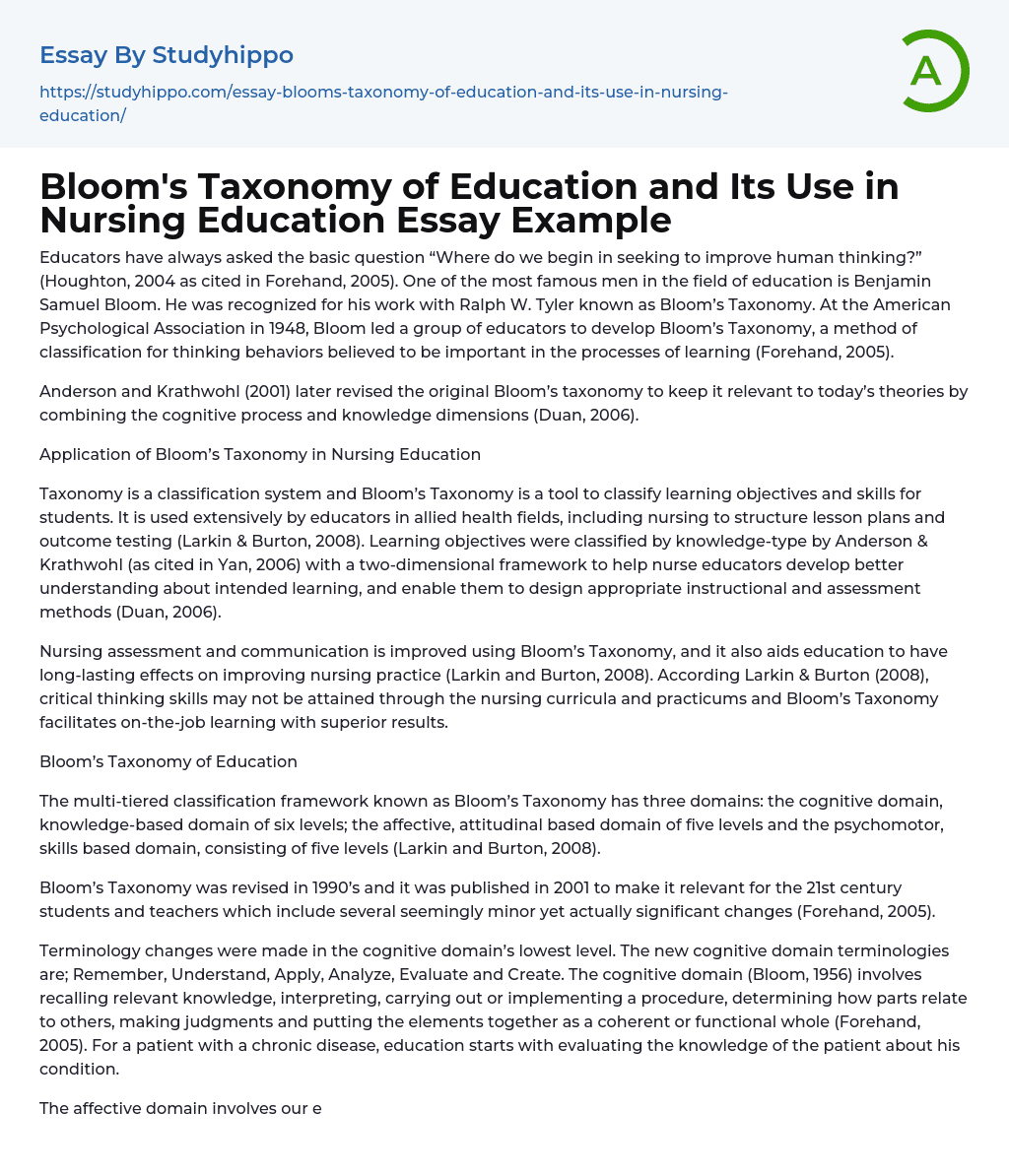

Bloom’s Taxonomy of Education and Its Use in Nursing Education Essay Example
Educators have always asked the basic question “Where do we begin in seeking to improve human thinking?” (Houghton, 2004 as cited in Forehand, 2005). One of the most famous men in the field of education is Benjamin Samuel Bloom. He was recognized for his work with Ralph W. Tyler known as Bloom’s Taxonomy. At the American Psychological Association in 1948, Bloom led a group of educators to develop Bloom’s Taxonomy, a method of classification for thinking behaviors believed to be important in the processes of learning (Forehand, 2005).
Anderson and Krathwohl (2001) later revised the original Bloom’s taxonomy to keep it relevant to today’s theories by combining the cognitive process and knowledge dimensions (Duan, 2006).
Application of Bloom’s Taxonomy in Nursing Education
Taxonomy is a classification system and Bloom’s Taxonomy is a tool to classify learning objectives and skills for
...students. It is used extensively by educators in allied health fields, including nursing to structure lesson plans and outcome testing (Larkin & Burton, 2008). Learning objectives were classified by knowledge-type by Anderson & Krathwohl (as cited in Yan, 2006) with a two-dimensional framework to help nurse educators develop better understanding about intended learning, and enable them to design appropriate instructional and assessment methods (Duan, 2006).
Nursing assessment and communication is improved using Bloom’s Taxonomy, and it also aids education to have long-lasting effects on improving nursing practice (Larkin and Burton, 2008). According Larkin & Burton (2008), critical thinking skills may not be attained through the nursing curricula and practicums and Bloom’s Taxonomy facilitates on-the-job learning with superior results.
Bloom’s Taxonomy of Education
The multi-tiered classification framework know
as Bloom’s Taxonomy has three domains: the cognitive domain, knowledge-based domain of six levels; the affective, attitudinal based domain of five levels and the psychomotor, skills based domain, consisting of five levels (Larkin and Burton, 2008).
Bloom’s Taxonomy was revised in 1990’s and it was published in 2001 to make it relevant for the 21st century students and teachers which include several seemingly minor yet actually significant changes (Forehand, 2005).
Terminology changes were made in the cognitive domain’s lowest level. The new cognitive domain terminologies are; Remember, Understand, Apply, Analyze, Evaluate and Create. The cognitive domain (Bloom, 1956) involves recalling relevant knowledge, interpreting, carrying out or implementing a procedure, determining how parts relate to others, making judgments and putting the elements together as a coherent or functional whole (Forehand, 2005). For a patient with a chronic disease, education starts with evaluating the knowledge of the patient about his condition.
The affective domain involves our emotions, values, and attitudes. The categories in this domain are receiving, responding, valuing, organizing and value concept. This domain pertains to our willing to hear and participate. We learn if we can place value on what we are about to learn and resolve our internal conflicts. How does the patient feel about his chronic condition? Does he value life and will the patient comply with the plan of care.
The third and last domain in Bloom’s Taxonomy is psycho-motor. This domain has five categories; Perception, manipulation, precision, articulation, and naturalization (Larkin & Burton, 2008). This pertains to use of our motor-skills. Here, the patient does not have to do much but take his medications at the prescribed
time and frequency. Motor skills become accurate and coordinated with less energy. Actions become automatic and without hesitation.
Conclusion
Bloom’s Taxonomy is easy to understand and makes logical progression from the fundamental learning to complex synthesis (Larkin & Burton, 2008). According to Anderson and Krathwohl (2001 as cited in Yan, 2006), Bloom’s Taxonomy offers a unique opportunity for instructional designers to match a cognitive skill to a specific knowledge level. It is very relevant to nursing education as in Benner’s Beginner to Expert practitioner theory of learning.
- Academia essays
- Higher Education essays
- Language Learning essays
- Studying Business essays
- Education System essays
- Study essays
- First Day of School essays
- Scholarship essays
- Pedagogy essays
- Curriculum essays
- Coursework essays
- Studying Abroad essays
- Philosophy of Education essays
- Purpose of Education essays
- Brainstorming essays
- Educational Goals essays
- Importance Of College Education essays
- Brown V Board of Education essays
- The Importance Of Higher Education essays
- Online Education Vs Traditional Education essays
- Academic And Career Goals essays
- Academic Integrity essays
- Brown Vs Board Of Education essays
- Distance learning essays
- Technology in Education essays
- Vocabulary essays
- Writing Experience essays
- Importance of Education essays
- Early Childhood Education essays
- Academic Degree essays
- Academic Dishonesty essays
- School Uniform essays
- Academic writing essays
- Cheating essays
- Bachelor's Degree essays
- MBA essays
- College Life essays
- Grade essays
- Diploma essays
- Phonology essays
- Sentence essays
- Filipino Language essays
- Pragmatics essays
- Millennium Development Goals essays
- History Of Education essays
- Graduate School essays
- Middle School essays
- School essays
- Special Education essays
- University essays



